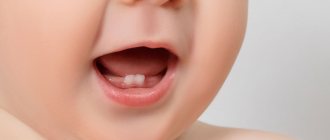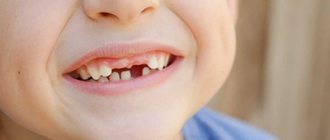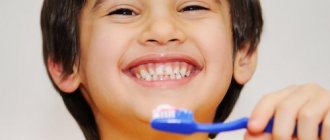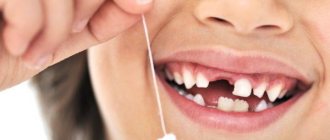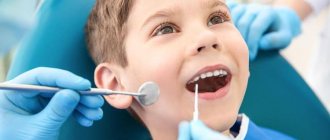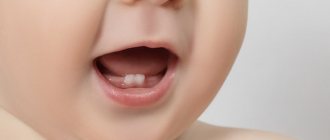Content:
- Why is it necessary to replace baby teeth with permanent ones?
- When do the first baby teeth fall out?
- Which baby teeth fall out first?
- Drop order
- At what age do radical units appear?
- Possible abnormalities in the child
- Why do empty spaces remain unoccupied for a long time?
As the child grows, the baby teeth are replaced by permanent ones. This is a natural process, without which the full functioning of the dentofacial apparatus is impossible. But parents should treat it with the utmost responsibility, since very often violations in the sequence of loss of temporary units cause serious malocclusions that have to be treated in the future.
What should parents do?
Losing primary teeth is a completely natural process and most often it is not accompanied by pain or complications. Nevertheless, in order to be sure of the baby’s health, you should follow a few simple rules:
- The teeth should fall out on their own. Do not pull out a tooth that has begun to loosen - you may accidentally damage a root that has not yet completely resolved and it will remain in the gum. You can help a tooth only if it really “hangs by one thread.” It’s even better if the tooth is removed by a pediatric dentist;
- After a tooth falls out, the wound may bleed. Give your baby a sterile gauze swab and ask him to bite down firmly - the bleeding will stop in a few minutes. Try not to feed your child for a couple of hours after losing a tooth. For the same period, you should give up hot, sour and salty foods;
- When changing teeth, it is very important to visit the dentist once every six months for preventive examinations. Your doctor will assess the general condition of your teeth and give recommendations on how to care for your baby and permanent teeth;
- Even though baby teeth are temporary, their condition must be treated very carefully. The health of temporary teeth directly affects the health of permanent teeth.
With each new permanent tooth, your child becomes more mature. Attentive attention to oral hygiene and regular dental checkups can give your child one of the main decorations: a healthy and beautiful smile.
Why is it necessary to replace baby teeth with permanent ones?
The chewing apparatus is improving and developing. In infancy, it is adapted exclusively for the intake of liquid food - breast milk. But closer to six months, you can already see baby teeth in children’s mouths. They allow the baby to get acquainted with the variety of solid adult foods.
There are few temporary teeth - ten pieces in each jaw. This is quite enough for the baby to eat well and talk normally. Closer to primary school age, the jaw grows. She is ready to cope with more serious chewing loads. Then children's incisors, canines and molars begin to wobble. They are replaced by a constant shift.
Doctor's advice when the process of changing teeth begins:
- After tooth loss, let your baby not eat for 3 hours, and you should also not drink very cold or hot drinks.
- Protect your child from sour, spicy and very sweet, astringent foods. All this has a negative impact on teeth.
- If your baby is bothered by discomfort or pain after a baby tooth falls out, then buy a special gel, but it is better to choose it on the recommendation of a dentist.
- Do not let your child touch the hole where a tooth has fallen out, as it may become infected.
- To soothe your mouth, make a decoction of chamomile.
Which baby teeth fall out first?
According to the standard pattern for replacing baby teeth, the lower incisors are the first to fall out. They are located in the center of the jaw. They can loosen one by one or almost simultaneously.
Following them, the opposite upper units begin to move. This is why you can often see children five or six years old with a funny toothless smile.
Drop order
The dropout pattern looks like this:
- 5-7 years - central incisors;
- 7-8 - lateral incisors;
- 9-11 - first molars of the upper jaw and second molars of the lower jaw;
- 9-12 - fangs;
- 10-13 - second molars of the upper dentition and first lower ones.
The diagram shows that the timing of changing units is quite arbitrary and quite long. This is why some children already have a permanent bite at the age of ten, while others still walk around at the age of 12 with actively loose baby teeth.
Where do teeth come from?
Teeth are formed in the fetus’s body during the mother’s pregnancy. When a mother abused something and undermined her own health, the subsequently born child was guaranteed to have diseased teeth that were no longer permanent. At the 15th week of pregnancy, the mother has hardened dental tissues in the fetus - starting from the crown area and ending with the root zone. The embryos of molar teeth are formed by the 5th month of fetal life. The body of a developing fetus and child is designed in such a way that in the upper jaw the anlage of the permanent teeth is located above the anlage of the milk teeth, and in the lower jaw - vice versa. The formation and development of teeth begins as early as the sixth week of fetal development. The source for them is a special epithelial dental plate. Already by 14 weeks of pregnancy, the unborn baby is actively forming hard dental tissues, initially in the area of the coronal part, and then in the area of the roots of the tooth. When a child is born, primary teeth are the first to grow - by the end of the child's first year of life, they will erupt. However, the dentition contains a group of large molars - they, in turn, do not have milk predecessors and subsequently, when they fall out, grow “on a permanent basis”. Nature has arranged it in such a way that while the child’s jaws are still too small, large molars are not needed there.
At what age do radical units appear?
We can talk about adult occlusion only a few years after the start of the change in time units. Typically, a stronger replacement will erupt several weeks or months (or, if pulled out prematurely, years) after the baby teeth fall out.
Central incisors grow from 6 to 8 years of age, lateral incisors from 7 to 9, premolars and canines from 9 to 12. Molars begin to grow at approximately six years of age. They immediately grow permanently, replacing the empty space.
Features of care
A permanent bite requires careful care and attention. First of all, parents should teach their child the rules of hygiene:
- using a toothbrush twice a day (at least 3 minutes);
- if possible, rinse your mouth after eating, especially when it comes to sweets;
- using dental floss to clean the interdental space.
In addition, preventive visits to the dentist are mandatory. At an early age, the enamel is more susceptible to the influence of external factors, so caries progresses quickly. The pathological process can also affect the pulp (its size in a child is larger than in an adult), which will require long-term and painful treatment.
Particular attention should be paid to a balanced diet, active recreation, and walks in the fresh air. If you live in a region where the number of sunny days per year is small, you should discuss with your pediatrician the issue of using vitamin D and preparations containing calcium.
Possible abnormalities in the child
Parents should know when to expect changes in their child's bite . Late change of baby teeth, like premature change, is undesirable. They speak of lateness when an eight-year-old child has not yet lost any of his incisors; they speak of early eruption if a five-year-old child has already lost many of his incisors and fallen out. It is important to find out the cause of the changes occurring and, if possible, eliminate it.
Factors due to which the bite changes earlier than standard periods:
- severe jaw injuries;
- congenital diseases leading to anomalies in the eruption of temporary and permanent units;
- advanced caries, due to which crowns and roots are destroyed faster than necessary.
As for a late shift, it is possible due to:
- rickets, calcium and vitamin D deficiency in the child’s body;
- hereditary characteristics of the dentofacial apparatus;
- some infectious pathologies.
Common problems with molars in children
| Problems with molars | How to fix? |
| Molar tooth is loose | A common occurrence with injuries and bruises. To avoid tooth loss, an urgent visit to the dentist and the application of a special splint are necessary, especially if the child’s molar sways when touched. |
| Broken molar tooth | Severe chips may require orthopedic treatment. If a child's front molar has chipped, aesthetic restoration with veneers or crowns may be required. |
| Molar caries | When the first molars erupt, it is important to prevent the occurrence of caries. If this happens, then it is necessary to stop the disease in its infancy, otherwise it will affect the deeper layers of the tooth. |
| A child's molar has fallen out | The most unpleasant thing that can happen. If a child knocks out a molar along with the root, then there is a chance to save it. To do this, you need to place the knocked out tooth back into the oral cavity, saline solution or into a glass of milk and urgently rush to the dentist (you need to do it within 30 - 40 minutes after the injury). If a child’s molar tooth has been removed, then there is only one way out - installing a prosthesis. |
Why do empty spaces remain unoccupied for a long time?
It often happens that a child walks around with a toothless smile for a long time, but the situation still does not change. When examining his oral cavity, the parents do not see even a hint of an imminent full bite. This happens when:
- Retentions. Dental pathology in which a segment of gum tissue is shown very little or not at all. The violation may be complete or partial. In any case, if it occurs, you should consult your dentist. Sometimes the situation can only be corrected through surgery.
- Edentia. The banal absence of a permanent germ. So, for example, a temporary fang falls out, and there is nothing to replace it with. The anomaly can be confirmed using x-ray diagnostics - the images show that the rudiment is missing. Fortunately, congenital adentia is rarely diagnosed in young patients. If it is, only prosthetics will save you.
- Impacts. Difficulties with eruption with this diagnosis are explained by the fact that the crowns of the “neighbors” are too close to each other and do not leave room for the crown, which should be between them. Deviations can also be detected using x-rays.
If there are any problems with the bite, parents should show the baby to the doctor. Moreover, children should have annual checkups at the dentist's office. This simple measure serves as an excellent prevention of serious complications and reduces the likelihood of an unattractive smile in adulthood.
Molars in children: symptoms of eruption
- Fever. When teething in children, body temperature may rise, usually not higher than 38 degrees.
- Itching and pain at the site where the molar appears. Various gels and ointments, as well as gum massage, will help relieve children from unpleasant sensations.
- Increased salivation and runny nose.
Important!
The growth of molars in children, especially at the initial stage, leads to weakened immunity. Take vitamins and do not forget about preventive visits to the dentist.


